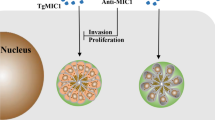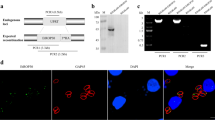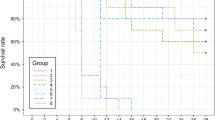Abstract
Background
In the past for more than 100 years at least 300 genotypes of Toxoplasma gondii were recorded and several traditional isolates such as RH, GT1, ME49, PRU and VEG were used repeatedly to clarify the pathogenic mechanisms and the epidemiological significance to human, but for if their virulence was mutative post-iterative passages it remains confused.
Objective
Therefore, in the study, seven genetically distinct T. gondii including C7 and PYS previously discovered in China were reidentified by sequencing the head of hsp40 locus to distinguish their virulence in vitro post-rejuvenation in vivo.
Results
Our data showed the nucleotides were different in 18 positions and 7 of them can be used to type T. gondii isolates. Total 634 plaques of T. gondii without two or more overlaps indicated that RH and GT1 tachyzoites possess stronger power than other five isolates in vitro (p < 0.001), followed by ME49, PRU, C7, PYS, and the weakest VEG. Based on the shapes of plaques, we found the ratio of their width/length was associated with the virulence of T. gondii, and speculated it could be used to judge T. gondii tachyzoites in vitro, whereas the data of simple linear regression analyses did not agree.
Conclusions
Together, virulence of seven genetically distinct T. gondii isolates that can be distinguished by seven mutative nucleotides in hsp40 was redefined in vitro post-rejuvenation in vivo, and it cannot be directly judged just according to the shapes of plaques formed in vitro.



Similar content being viewed by others
Data availability
The datasets generated and analyzed during the current study are available from the corresponding author on reasonable request.
References
Garnaud C, Fricker-Hidalgo H, Evengård B, Álvarez-Martínez MJ, Petersen E, Kortbeek LM, Robert-Gangneux F, Villena I, Costache C, Paul M, Meroni V, Guy E, Chiodini PL, Brenier-Pinchart MP, Pelloux H (2020) Toxoplasma gondii-specific IgG avidity testing in pregnant women. Clin Microbiol Infect 26(9):1155–1160. https://doi.org/10.1016/j.cmi.2020.04.014
Galván-Ramírez ML, Sánchez-Orozco LV, Gutiérrez-Maldonado AF, Rodriguez Pérez LR (2018) Does Toxoplasma gondii infection impact liver transplantation outcomes? A systematic review. J Med Microbiol 67(4):499–506. https://doi.org/10.1099/jmm.0.000694
Safarpour H, Cevik M, Zarean M, Barac A, Hatam-Nahavandi K, Rahimi MT, Bannazadeh Baghi H, Koshki TJ, Pagheh AS, Shahrivar F, Ebrahimi M, Ahmadpour E (2020) Global status of Toxoplasma gondii infection and associated risk factors in people living with HIV. AIDS 34(3):469–474. https://doi.org/10.1097/QAD.0000000000002424
Su YJ, Ma ZD, Qiao X, Wang PT, Kang YT, Yang NA, Jia W, Zhao ZJ (2022) Geospatial epidemiology of Toxoplasma gondii infection in livestock, pets, and humans in China, 1984–2020. Parasitol Res 121(2):743–750. https://doi.org/10.1007/s00436-021-07415-1
Coutermarsh-Ott S (2019) Toxoplasma gondii as a model of in vivo host-parasite interactions. Methods Mol Biol 1960:237–247. https://doi.org/10.1007/978-1-4939-9167-9_21
Szabo EK, Finney CAM (2017) Toxoplasma gondii: one organism, multiple models. Trends Parasitol 33(2):113–127. https://doi.org/10.1016/j.pt.2016.11.007
Valenzuela-Moreno LF, Méndez-Cruz ST, Rico-Torres CP, Cedillo-Peláez C, Correa D, Caballero-Ortega H (2022) SAG3 Toxoplasma gondii cloning reveals unexpected fivefold infection in the blood of feral cats in the Mexican Caribbean. BMC Vet Res 18(1):33. https://doi.org/10.1186/s12917-021-03129-9
Li ZY, Guo HT, Calderón-Mantilla G, He JJ, Wang JL, Bonev BB, Zhu XQ, Elsheikha HM (2020) Immunostimulatory efficacy and protective potential of putative TgERK7 protein in mice experimentally infected by Toxoplasma gondii. Int J Med Microbiol 310(5):151432. https://doi.org/10.1016/j.ijmm.2020.151432
Pinto-Ferreira F, Paschoal ATP, Pasquali AKS, Bernardes JC, Caldart ET, Freire RL, Mitsuka-Breganó R, Navarro IT (2021) Techniques for inactivating Toxoplasma gondii oocysts: a systematic review. Rev Bras Parasitol Vet 30(2):e026420. https://doi.org/10.1590/S1984-29612021040
Antil N, Kumar M, Behera SK, Arefian M, Kotimoole CN, Rex DAB, Prasad TSK (2021) Unraveling Toxoplasma gondii GT1 strain virulence and new protein-coding genes with proteogenomic analyses. OMICS 25(9):591–604. https://doi.org/10.1089/omi.2021.0082
Djokic V, Blaga R, Aubert D, Durand B, Perret C, Geers R, Ducry T, Vallee I, Djurkovic Djakovic O, Mzabi A, Villena I, Boireau P (2016) Toxoplasma gondii infection in pork produced in France. Parasitology 143(5):557–567. https://doi.org/10.1017/S0031182015001870
Uzelac A, Klun I, Ćirković V, Djurković-Djaković O (2020) In vivo and In vitro virulence analysis of four genetically distinct Toxoplasma gondii lineage III isolates. Microorganisms 8(11):1702. https://doi.org/10.3390/microorganisms8111702
Bartley PM, Wright S, Sales J, Chianini F, Buxton D, Innes EA (2006) Long-term passage of tachyzoites in tissue culture can attenuate virulence of Neospora caninum in vivo. Parasitology 133(Pt 4):421–432. https://doi.org/10.1017/S0031182006000539
Zhao P, Wang S, Chen Z, Yu J, Tang R, Qiu W, Zhao L, Liu Y, Guo X, He H, Xu G, Li J, Wu J (2020) Successive passage in vitro led to lower virulence and higher titer of a variant porcine epidemic diarrhea virus. Viruses 12(4):391. https://doi.org/10.3390/v12040391
Khan A, Grigg ME (2017) Toxoplasma gondii: laboratory maintenance and growth. Curr Protoc Microbiol 44:20C.1.1-20C.1.17. https://doi.org/10.1002/cpmc.26
Li ZY, Wang ZD, Huang SY, Zhu XQ, Liu Q (2016) TgERK7 is involved in the intracellular proliferation of Toxoplasma gondii. Parasitol Res 115(9):3419–3424. https://doi.org/10.1007/s00436-016-5103-5
Li ZY, Lu J, Zhou DH, Chen J, Zhu XQ (2015) Sequence variation in HSP40 gene among 16 Toxoplasma gondii isolates from different hosts and geographical locations. Biomed Res Int 2015:209792. https://doi.org/10.1155/2015/209792
Zhou P, Zhang H, Lin RQ, Zhang DL, Song HQ, Su C, Zhu XQ (2009) Genetic characterization of Toxoplasma gondii isolates from China. Parasitol Int 58(2):193–195. https://doi.org/10.1016/j.parint.2009.01.006
Sibley LD, Boothroyd JC (1992) Virulent strains of Toxoplasma gondii comprise a single clonal lineage. Nature 359(6390):82–85. https://doi.org/10.1038/359082a0
Dubey JP (1996) Infectivity and pathogenicity of Toxoplasma gondii oocysts for cats. J Parasitol 82(6):957–961
Hou Z, Zhou Y, Liu D, Su S, Zhao Z, Xu J, Tao J (2018) Genotyping and virulence analysis of Toxoplasma gondii isolates from a dead human fetus and dead pigs in Jiangsu province, Eastern China. Acta Parasitol 63(2):397–411. https://doi.org/10.1515/ap-2018-0046
Acknowledgements
This study was supported, in part, by the Fourth Phase Training Program of Guangxi One Thousand Young- and Middle-aged Core Teachers in University (Grant no. 2020-58), the Innovation Project of Guangxi Graduate Education (Grant no. JGY2022198), the Natural Science Funds of Guangxi Zhuang Autonomous Region and Anhui Province (Grant nos. 2019GXNSFBA185031 and 1908085QC117), and the Introduced Doctoral Research Project of Guilin Medical University (Grant no. 31304018021).
Author information
Authors and Affiliations
Contributions
ZL and HG conceived and designed the study. HG, JT and ZL performed the experiments, and drafted the manuscript. YH, SY and KJ helped in the implementation of the work. ZL critically revised the manuscript. All the authors read and approved the final manuscript.
Corresponding author
Ethics declarations
Conflict of interest
All the authors declare no conflict of interests.
Ethical Approval
Animal experiment was strictly carried out according to the guidelines of the Animal Ethics Procedures of the People's Republic of China, and the procedures performed in this study were approved by the Experimental Animal Ethics Committee of Guilin Medical University (Approval No. GLMC202203073).
Additional information
Publisher's Note
Springer Nature remains neutral with regard to jurisdictional claims in published maps and institutional affiliations.
Supplementary Information
Below is the link to the electronic supplementary material.
Rights and permissions
Springer Nature or its licensor (e.g. a society or other partner) holds exclusive rights to this article under a publishing agreement with the author(s) or other rightsholder(s); author self-archiving of the accepted manuscript version of this article is solely governed by the terms of such publishing agreement and applicable law.
About this article
Cite this article
Guo, H., Tan, J., He, Y. et al. In Vitro Virulence Contrast of Seven Genetically Distinct Toxoplasma gondii Isolates After Rejuvenation In Vivo. Acta Parasit. 69, 227–232 (2024). https://doi.org/10.1007/s11686-023-00740-8
Received:
Accepted:
Published:
Issue Date:
DOI: https://doi.org/10.1007/s11686-023-00740-8




